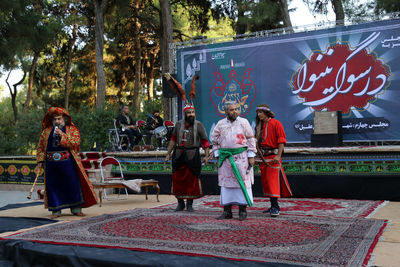“Tazieh and other ritual performances are considered the certificate of art and culture of Iran. A major part of the habits, traditions, and religious beliefs of the country are rooted in these ritual performances, which indicate the deep and rich culture of Iranians,” he said.
“Out of different ritual performances, tazieh is the crème de la crème of the plays rooted in religious beliefs and has been a symbol for commemorating the uprising of Imam Hussein (AS) and the Ashura movement,” he said.
He added that Islam is the religion of kindness, sacrifice, and peace, and the lives of Prophet Muhammad(S) and Imams(AS) are good examples of these issues.
“Tazieh tries to depict part of the life of the Imams especially Imam Ali (AS), the first Imam of the Shia, and Imam Hussein (AS), the third Imam of the Shia,” he noted.
He added that tazieh performers try to reflect part of the lives and ethics the Imams as the most positive role models for Muslims.
“Concurrent with the spread of coronavirus in the country and the big changes in our lifestyles, we organized festivals of tazeih and naqqali [a dramatic style of storytelling],” he said.
“Ritual performances attract larger audiences because of their simple and freestyles of narrations. And, fortunately, the center has been able to produce and release a number of ritual plays on social networks, something that has been warmly received by individuals,” he remarked.
The Art Bureau’s Center for Dramatic Arts has recorded ten tazieh performances broadcasted from the Iranian TV channels during the first days of the lunar month of Muharram, which is observed every year with rituals for the martyrdom anniversary of Imam Hussein (AS) and his companions.
Tazieh masters and performers from the different cities of Arak, Qom, Tafresh, Isfahan, Qazvin, and Tehran performed the passion plays, and morshed Mohsen Mirza-Ali was the coordinator for the project.
The center is planning to commemorate Arbaeen across the country with several additional programs.
Arbaeen marks the end of the 40-day mourning period following the martyrdom of the Imam and his loyal companions on Ashura.
Source: Tehran Times

